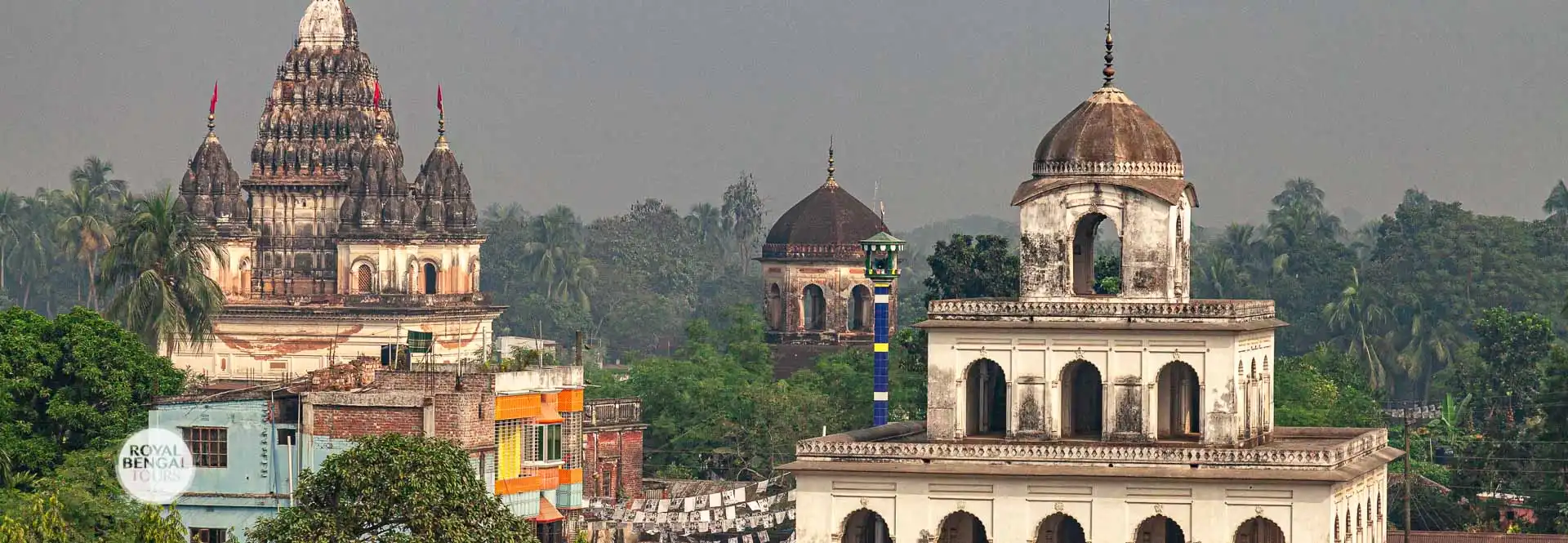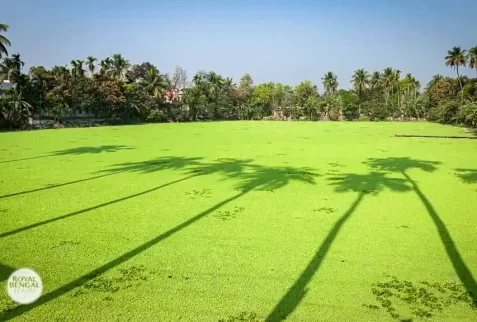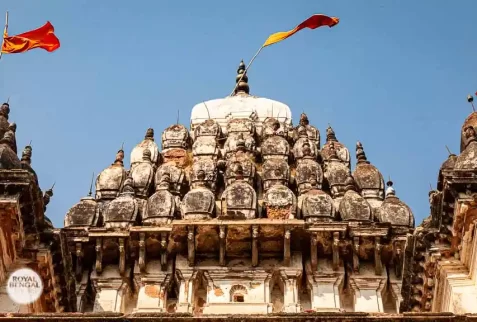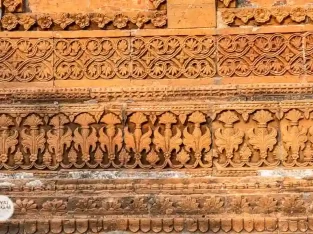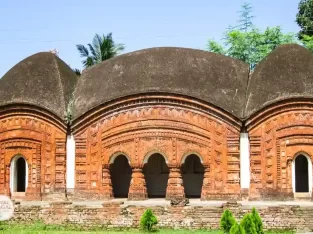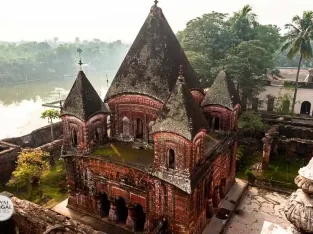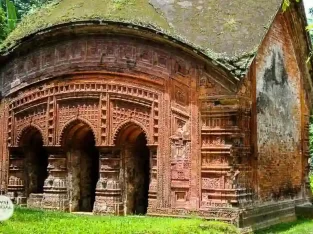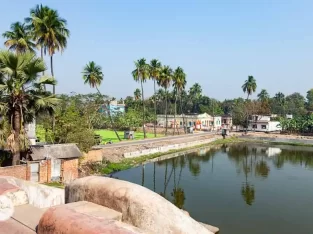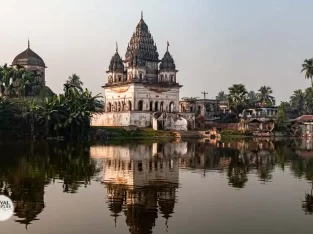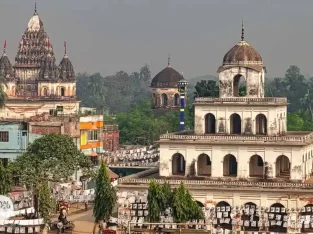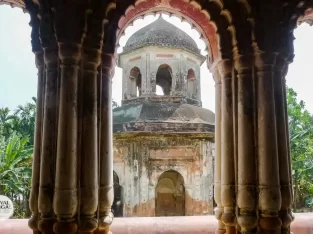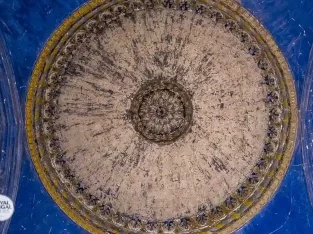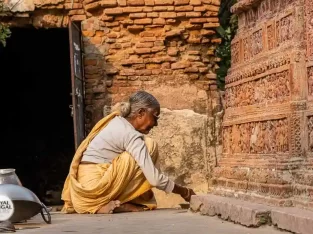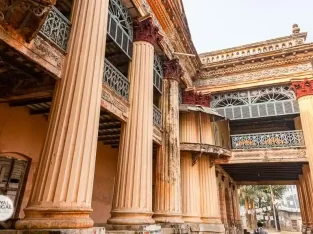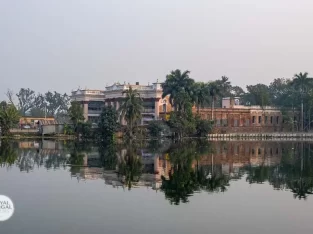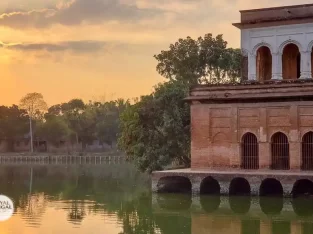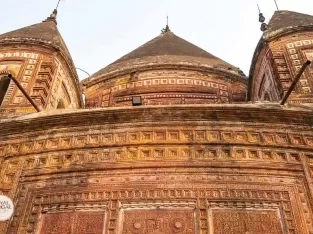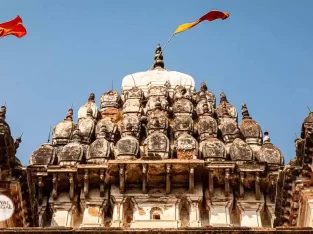Bhubaneshwar Shiva temple is the largest Shiva temple in Bangladesh, an exceptional and attractive for its different architectural style with a plastered finish, is a typical Pancha-Ratna temple style of north India.
The whole structure of this lofty brick-built temple is placed on a large square (65′-0″) and raised platform of (11′-8″) height. It has only one square chamber, measuring 12′-9″ in the centre, surrounded by four small 9′-3″ rectangular rooms at each corner and four covered verandahs in between the corner rooms. Inside of the central square chamber lies a huge Black-basalt Shiva lingam, which is the largest one in the country. This Shiva Lingam is an excellent example of delicate hardstone carving and beautiful sculptural artwork. During Bangladesh – Pakistan liberation war in 1971, the Pakistani military tried to destroy the this Shiva Lingam. Fortunately, their effort has gone to waste; they could not move this giant lingam but has disfigured.
Two different staircases approach to the high platform, brick-built one is on the northern side, and another stone-made staircase is the main entrance to the southern side.
Five ornamental ratnas crowns the temple. The outer and inner walls are plastered with few vertical panels which embellished some mythological figures. About three millions of taka were expended to built this temple at that time.
Char Ani palace
Once magnificent palace Char Ani palace is now just a ruin. Standing on the southern bank of pond Shan Sharobar, and the western side of the Panch Ani Palace. It was built over 4.80 acres of land area in 1886, which is no more visible excepts some ruin axis of the building. Only surviving ruined condition is its entrance portal, Khazanchi Khana (treasury house) and the Kachari Bari.
Pancha – Ratna (five-towered) Bara Govinda Temple
The Govinda temple at Puthia of Rajshahi district is an excellent example of the Pancha-Ratna or five spire temples in combination with typical Jor – Bangla style. The similar method has been followed on many temples in Jessore and Khulna area too.
The Govinda Temple was built between 1823 and 1895 by one of the Maharanis of the Puthia estate. The imposing temple is located inside the Panch-Ani Palace, on the left-hand side of the inner courtyard. The brick-built structure placed on 47′-6″ square raised platform, and a set of ornamental miniature towers are crowning the two-storeyed temple. There are four ornamented towers (ratnas) on each corner of the first storey, and a central one is crowning the top of the second. The whole outer wall surface of this well-preserved living temple is extensively ornamented with continuous strips of terracotta panels, predominantly depicting various episodes from great epic, the legends of Radha-Krishna, Ramayana and Mahabharata battle story, various floral and geometric designs, pictures from the Hindu epics and different mythological figures.
Especially the western facade is depicted with Lanka-Kanda, the divine romance of Radha and Krishna, ten deities (a line of terracotta panels under the curved cornice) and contemporary culture and social life (two lines of terracotta panels on the lower portion of the temple) like the Kantajee in Dinajpur.
The ground plan refers that the temple has a square room in the centre, surrounded by four small square rooms on four corner and four tiny verandahs on four sides with three cusp arched doorways. The rooms are covered with semi-circular dome and verandahs are barrel vaults. Externally it is crowned by five ornamental towers (Ratnas) which covered with the pyramidal shape of Chautala vaults. This temple is exceptional for its outer wall surface ornamentation. This temple is in regular worship by the local Hindu devotees.
Do-Chala Chhota Ahnik Temple
This east facing brick-built temple is located close to the north-west corner of Maharani Hemantakumari residence. Ground plan of this temple is rectangular, has a triple archway in the east and one in the south. The inner wall surface of this temple are plastered, but the eastern and southern facades are embellished with terracotta plates portraying Radha-krishna-Balram myths, the episode of Ramayana and floral motifs like the Bara Govinda Temple. A do-chala roof covers the whole structure with curved cornice. This temple was erected during the first decade of the 19th century.
Bara Ahnik Temple
This east facing temple is standing on the western bank of the Shyamsagar (Sarobar) and in front of the Char-Ani Rajbari. It is an exceptional temple style in Bangladesh from the structural points of view, Raja Ram temple in Khalia of Faridpur is the only closer example to a similar style. This temple has three chambers, do-Chala in the centre and two chouchala chambers are attached on the north and south side. Therefore this style is also called tri-mandir. The central do-Chala chamber has a triple archway with an open platform on the front side. The eastern facade is highly decorated with terracotta plates, unfortunately falling apart due to lake of maintenance. This contemporary of Chhota Ahnik Mandir was erected by the Char Ani Rajas of Puthia estate.
Dol – Mandav or Dol – Temple
Dol temple is located precisely on the opposite of the Royal Palace, having an open field in between. This unique style brick-built 65′ high Hindu temple was erected by Raja Vubanendra Narayan in 1778. This square-shaped four-story building is gradually rising upwards, reducing chamber sizes from all side in each upper floor then the lower ones, and consequently, the top level is the smallest. Therefore the whole structure is a pyramidal shape. The entire wall surfaces have been simply coated with a layer of plaster, and each storey is opened with arcades. The top square room is crowned with a ribbed dome, and the dome is ornamented with a kalsha finial. This temple offers a great view to all around from its top floor.

